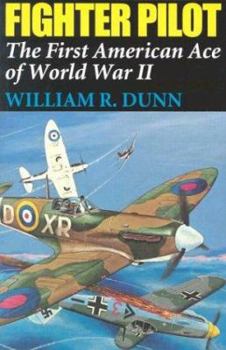Fighter Pilot-Pa
Select Format
Select Condition 
Book Overview
At the age of twelve, American William R. Dunn decided to become a fighter pilot. In 1939 he joined the Canadian Army and was soon transferred to the Royal Air Force. He was the first pilot in the famous Eagle Squadron of American volunteers to shoot down an enemy aircraft and later became the first American ace of the war. After joining the U.S. Army Air Corps in 1943, he saw action in the Normandy invasion and in Patton's sweep across France. Twenty...
Format:Paperback
Language:English
ISBN:0813108675
ISBN13:9780813108674
Release Date:March 1996
Publisher:University Press of Kentucky
Length:272 Pages
Weight:0.90 lbs.
Dimensions:0.7" x 5.5" x 8.4"
Customer Reviews
3 ratings
An amazing book of world war two flying at its greatest.
Published by Thriftbooks.com User , 21 years ago
An exhilarating book of courage, passion, and determination, Fighter Pilot; The First American Ace of World War Two by William R. Dunn, is the biography of a Midwestern boy and his journey to become the first American Ace of World War Two. Starting as a young child listening to his relatives tall tales of aerial combat during World War One, the young William Dunn yearns for the rush and excitement of combat over the front lines. This young man showed an uncanny devotion to aviation, and even when he was forcefully retired from his rank of Lt. Colonel at the end of World War Two, he re-enlisted in the USAF as a Tech Sgt. This is the type of book that you are unable to set down. Once the reader has started to read into the life of this amazing man, you feel like you were right there flying top cover for this Hurricane, Spitfire, Thunderbolt, and Mustang pilot. His highly detailed accounts of his aerial victory's and of the aircraft he flew and flew against is truly a work of pure genius. Setting the rumors to fact based on personal experiences, he eliminates many discrepancies about World War Two aerial combat. His accounts of daily life in Eagle Squadron No. 71, comprised of all American volunteers flying for the Royal Air Force, tell of the struggles these men faced. The stories also tell of the happy times, of nights at the USO, having a lively night at the local bar, or just sharing letters from home, makes you feel for those men. The different tales from three different armed forces, gives the reader a sense of how well coordinated, from a tactical aspect, the allied war effort really was. A good show to Mr. William R. Dunn for his great book. It is truly and aviation classic.
A very entertaining biography of an unusual individual.
Published by Thriftbooks.com User , 24 years ago
William R. Dunn, with a slightly cliched but quite capable and at times understated style, tells his own story. It is about a person who engaged in more adventures than most of us could conceive. He rounded up and broke wild horses in the 1930's in the American West, fought with a Canadian highland regiment in France, became the first American ace with the RAF Eagle Squadron, helped force the German's back to Germany with the USAAF 9th Air Force, continued with Chenault and Chiang in China and, to cap his long career, contributed with the US Air Force in Viet Nam. In his childhood, the author set a goal to be a flyer. He never wavered in its pursuit until he achieved the goal and then never stopped flying until first the Air Force asked him to retire and then death finally revoked his pilot's license.His perseverance was evident by the fact that after marrying a Canadian girl in 1943 he only visited her and his son on two brief occaisions until he finished in China in 1947. Of course, she did the right thing. He also didn't quit when the Air Force retired his lt. colonel rank after the war and he re-enlisted as a technical seargeant. The bureaucrats involved with his loss of rank should have been court marshalled by the way.An interesting footnote is that he was proud of his marksmanship with weapons. He shot down two German bombers with a puny Lewis Gun as an infantryman. He was a relatively prolific scorer compared with his peers as a fighter pilot in Hurricanes and Spitfires. Then, after an accident when attempting to take off with a Thunderbolt he mentioned that he wasn't seriously hurt and in passing that it only cost him the sight in one eye. While it wasn't clear when his vision became monocular, he did fly the next day. My point is that he never shot down another airplane in his long subsequent career after this incident despite some opportunities. Though Bill never commented on it in the book, I wonder if his sight was a factor.
Well written,clear and factual. Bill writes the way it was.
Published by Thriftbooks.com User , 24 years ago
I first became interested in Bill's story while I was doing research for a painting I was preparing for an American Society of Aviation Artists annual seminar. We talked many times on the phone when I needed some detail or other for the painting, and he offered to send me a copy of his book. When I started to read it, I couln't put it down. He even autographed it for me and is now one of my treasured possesions. Since the seminar was in the same town he lived, I invited him to the show to see the painting I had done of the Hurricane he flew in No.71 Sguadron of the Eagle Squadron RAF. It was a very emotional for both of us, especially when he turned to me and said,"that's just the way it was".He really was America's First Ace of WW2.





